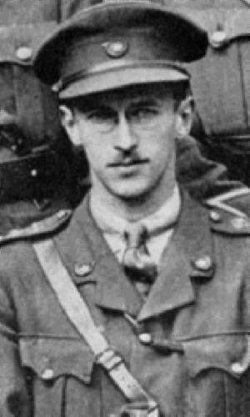Topic: Military Theory

 The "Man-in-the-Dark"
The "Man-in-the-Dark"
The "Man-in-the-Dark" Theory of Infantry Tactics and the "Expanding Torrent" System of Attack.
By Captain B.H. Lidell-Hart, K.O.Y.L.I., [Presented] On Wednesday, November 3rd, 1920, at 3 p.m. and published in the Journal of The Royal United Service Institution; February, 1921
Thus the man-in-the-dark resembles the commander in modern war. Let us examine the correct principles of action which a man seeking to attack an enemy in the dark would naturally adopt.
"The Man Fighting in the Dark."
1. In the first place he must seek his enemy. Therefore, the man stretches out one arm to grope for his enemy, keeping it supple and ready to guard himself from surprise.
This may be termed the principle of "protective formation."
2. When his outstretched arm touches his enemy, he would rapidly feel his way to a highly vulnerable spot, such as the latter's throat.
This is the principle of "reconnaissance."
3. The man will then seize his adversary firmly by the throat, holding him at arm's length so that the latter can neither strike back effectively, nor wriggle away to avoid or parry the decisive blow.
This is the principle of "fixing."
4. Then while his enemy's whole attention is absorbed by the menacing hand at his throat, with his other fist the man strikes his opponent from an unexpected direction in an unguarded spot, delivering out of the dark a decisive knock-out blow.
This is the principle of "decisive manoeuvre."
5. Before his enemy can recover the man instantly follows up his advantage by taking steps to render him finally powerless.
This is the principle of full and immediate "exploitation" of success.
To follow these principles is the only sure path to victory. We can only neglect the fixing phase, if our enemy commits some mistake, such as the neglect of his own security, by which he fixes himself without our intervention and so exposes himself to our decisive blow.
Now the whole action of our man-in-the-dark can be simplified into two categories:-
When the man has fixed his enemy, he delivers a decisive knockout blow. It will be obvious that the harder this blow the more likely it is to be decisive. Hence the man must put his maximum possible force into it, while he only uses the necessary minimum of strength to carry out the preparatory operations. This is the principle of "Economy of Force." But the man can increase the effect of his available strength by surprising the enemy; by his speed; by the momentum or "follow through" behind his blows; by striking his opponent's most vulnerable spots; by full exploitation of every opening or advantage; by husbanding his energy; and by moving his limbs and muscles in harmony like the parts of a well-oiled machine. All these are means to promote economy of force, and therefore can be grouped under that principle.
Thus we see that there are two, and only two, supreme governing principles - Security and Economy of Force.
Read the complete paper by Liddell-Hart.

